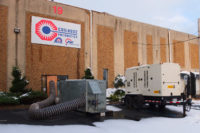Restoring Long Island in Superstorm Sandy’s Aftermath
Both Long Island homes took two days to complete deconstruction and the damage estimates were between $6,000 and $6,500








The devastating effects of last October’s Superstorm Sandy were felt throughout the Northeast, leaving thousands of homes damaged and millions of residents without power. Playing a large and critical role in any natural disaster recovery are property restoration professionals. PuroClean mobilized over one-third of its system to regions affected by the storm - technicians drove from as far as Texas, Ohio and Missouri to help those in need. Thomas Maguire of Spartanburg, SC is just one of those restoration professionals who spent several weeks helping restore the homes of victims of Superstorm Sandy, specifically those on Long Island – one of the storm’s most hard-hit areas.
Maguire and his crew arrived on site four days after Sandy had ripped through the area and was asked to help with two side-by-side homes in Massapequa through word of mouth. Fortunately, there was still time to save much of the base structure of the properties before irreversible damage ensued, such as significant mold growth. The first step consisted of meeting with the homeowners, assessing the damage and thoroughly inspecting the entire home room by room. Throughout this process, it was (as is always) imperative to communicate to the resident exactly what the team would be doing, as well as timing, cost, procedure, etc. Each home required a team of six to eight workers, which consisted of a mix of PuroClean employees and local workers brought on as temporary employees.
After preparing a plan of action, the crew removed all contents before the deconstruction and drying phases. The homeowners of the first project had already removed most of their content to their front lawn. The second home’s walls were covered in artwork, which Maguire’s team removed and sanitized. All of the non-salvageable items were recorded for the homeowner’s insurance claims purposes before removal and disposal.
Working from the top down, crews began the demolition phase. Maguire and his workers used power saws to take out the drywall – finding seams and, where possible, pulling out whole pieces that were dry enough to stay intact – and then removed the insulation from all exterior walls. In the first home, crews removed up to six feet of tiling in a downstairs bathroom because the drywall behind was completely saturated. The kitchen cabinets in both homes were ruined, but the crew was able to save the granite countertops. Next, the team removed and disposed of the (previously) beautiful hardwood floors in both homes due to severe cupping, which was not restorable. Though the homes were similar, the second was built on a slightly higher elevation where the water was not quite as high in the structure, thereby preventing greater damage.
The tear-out phase concluded with the crawl spaces. The crawl space in the first home was full of waste - dead animals, seaweed and debris - that had been washed underneath the home from the ocean water and neighboring yards. Crews pulled out all of the insulation and debris using steel rakes. The second home’s crawl space was also filled with water but because the walls and floor were concrete. Crew members were able to remove the water and insulation without having to contend with any storm debris.
Once all of the affected materials had been removed, Maguire led a detailed cleaning process. Everything was thoroughly cleaned and disinfected to remove potential microbial growth. Even with the cold temperatures preventing rapid progression, mold begins to develop within four to five days after a storm like Sandy. The crews also treated the remaining affected building components with antimicrobial disinfectant.
Maguire and his team then began the final stage of the process – the drying phase. He chose to use all low-grain refrigerant dehumidifiers, HEPA air scrubbers and professional air movers. Though most homes typically required three days of drying, the first house in Massapequa took a bit longer due to lack of consistent power, a common challenge with any storm recovery project. In some instances, restoration teams were forced to do the tear-out and wait, returning when power was restored.
Another challenge Maguire experienced was managing his work force. “You’re always going to have those who want to work all night and do whatever it takes to get the job done, but as important as working against the clock is, we need to make sure our crew is well rested and taken care of so they can do their best,” he said.
Had Maguire and his team arrived any later, the homes would have been in significantly worse shape. Mold and bacteria growth would have only continued to worsen and the building materials would have swollen, making it much more difficult to restore. Moreover, serious mold growth impacts everything – cost alone can be four to five times higher. If a home is not dried properly, many other contents unaffected by storm water will begin to show signs of mold growth because of high humidity. This “rainforest effect” will cause mold to grow on wood furniture, walls and fabric, among other surfaces.
Both Long Island homes took two days to complete deconstruction and the damage estimates were between $6,000 and $6,500. Maguire’s key takeaways from these and other similar Sandy-related jobs always come back to understanding what the homeowners are going through.
“A big part of our job is to recognize that people affected by tragedies beyond their control are going through a difficult time,” he says. “Our main priority is helping others recover from their worst day when their entire world has just been turned upside down. It takes patience, understanding and the right attitude.”
Looking for a reprint of this article?
From high-res PDFs to custom plaques, order your copy today!








